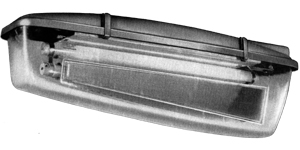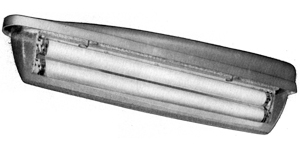 |
GEC Z8256
Genre: Enclosed Horizontal Traverse Tubular Fluorescent Lantern
After the invention of the tubular fluorescent lamp in 1937 by GE of America, its application to street
lighting was immediately recognised, but all development was delayed by the Second World War. After hostilities
ceased, trial installations using tubular fluorescent lamps were installed in Dublin (using trough
reflectors) and a year later in Rugby and London (using scientifically designed lanterns).
The advantages of fluorescent tubes was immediately apparent. The fluorescent tube was ideally suited for road
lighting, casting a wide beam across the road surface and was relatively unaffected by wet conditions
(which lead to streaks from more compact light sources). It's non-dazzling white light (due to the low
surface brightness of the tube itself) made it an ideal solution for the lighting of high streets, promenades and
civic areas, with smaller units used for residential streets. The only problem was the size of the tubes, which in turn
lead to large lanterns.
The first fluorescent lanterns were huge, bulky affairs, their size dictated by the bulb lengths, the enormous gear
and the limitations of the raw materials of the late 1940s: the lanterns consisted of plate glass panels and metal frames. The optical
system was also complex
treating each lamp as individual source and concentrating its beam in one area using parabolic polished
metal reflectors. Their large size, and equally large capital cost, made lighting authorities hesitant to use
these lanterns.
Fluorescent's popularity increased as new aluminium alloys allowed lighter one-piece canopies to be cast,
which in turn supported new plastic moulded bowls. The optical systems changed again with all the tubes
contributing to the whole: a primary system of lightweight plastic refractors directed the flux onto the road
surface and fashioned the main beams; whilst a secondary system (comprising of white over-reflector)
directed light above the horizontal back to the refractor plates.
Therefore the lanterns became simpler to manufacture and, in turn, their purchase price decreased. They
were still an expensive option, but authorities could justify their use due to their excellent white light (as
compared to the more "artificial" coloured mercury and sodium lanterns). Fluorescent lighting was especially
popular in new town developments and many manufacturers pointed this out in advertisements.
The lantern's large size was still a problem and manufacturers took a tip from European practise and angled
the lantern slightly to disguise its length. Whilst this threw the light further across the road, it was usually
done for cosmetic reasons alone.
The 1950s and 1960s were the age of the fluorescent lantern: it's white light seen as an energy efficient
replacement for ageing tungsten and gas lighting. As gear sizes were gradually decreased, the manufacturers
took advantage by streamlining the lanterns further. Optical systems became simpler until they eventually
consisted of no more than the tubes themselves with a small over reflector.
The energy crisis of the 1970s prompted a rethink. The complex white light fluorescent lantern, usually
burning multiple tubes, was seen as an expensive luxury: a unit burning two 40W bulbs could be replaced by
a single low pressure sodium lantern burning a 35W bulb. The idea that orange light was unsuitable for
residential areas and high streets was swept away by economic necessity. Therefore, as an energy saving measure,
the tubular fluorescent lantern was gradually removed, to the extent that hardly any exist on
public streets anymore.
The use of the tubular fluorescent lamp for street lighting was over. (Although the future looks bright for the
compact fluorescent lamp but that's another story...)

Name: GEC Z8256
Date: Circa 1960s
Dimensions: Length: 31¼", Width: 9½", Height: 11"
Light Distibution: Non Cut-Off (BSCP 1004:1952)
Lamp: 2 x 40W MCFE/U
History

GEC Z8256

GEC Z8260
|
The Z8256 lantern was a modification of the earlier popular Z8254 fluorescent lantern. The changes were primarily
to the lamp positioning, slanting the bottom tube upwards at an angle from the street side to the road side. The bowl was also changed to
match this profile.
These changes appeared to be primarily concerned with reducing the size of the lantern and removing the need for it to be tilted.
(Fluorescent lanterns were often mounted on tilted brackets to disguise their size and to throw more light
across the road). By fitting the lantern with an internally tilted tube, and breaking the horizontal lines of the lantern,
the GEC engineers ensured the lantern could be mounted on standard non-tilted brackets.
This idea appeared to be short lived as the two lanterns which superseded it (including the Z8260) returned to parallel bulbs.
|
Popularity
The lantern was very popular in various London suburbs (including Richmond and Kew). However, most were removed
during the energy crisis of the 1970s and the lantern was almost extinct by the 1990s.
Identification
The lantern has GEC Made In England cast into the canopy. But its large size, distinctive bowl profile and large stainless steel clips make identification easier.
Optical System
The primary optical system is comprised of two plate refractors positioned either side of the tubes. As a fluorescent tube already casts a wide beam
in azimuth, the horizontal refractors simply alter the flux elevation by fashioning two main beams in a non-cut-off distribution (in accordance with the BSCP 1004:1952).
The secondary optical system includes a white-enamelled over-reflector. It simply reflects flux emitted above the horizontal
back down towards the ground.
Gear
The lantern is fitted with a choke, power correction capacitor and quickstart fluorescent
starter unit. Smaller capacitors are connected across the quickstart unit to suppress radio interference.
The bi-pin fluorescent connectors are not earthed, suggesting these lanterns used MCFE/U lamps.
The GEC Z8256 In My Collection

|
|
facing profile
This lantern was aquired from fellow collector P.. Little is known about its service history other
than it originally stood somewhere near Epsom, Surrey.
|
|

|
|
front profile
The lantern was just starting to show signs of wear of over forty years in service. The Perspex
bowl had discoloured, becoming milky with age, and was starting to split due to expansion of the
metal rivets holding the bowl catches.
|
|

|
|
trailing profile
The vertical splits in the bowl can be clearly seen here. The refractor plates had also dropped off (the internal glue having failed)
and had been discarded in the past.
|
|

|
|
canopy
Two pairs of toggle clips held the bowl in place. These obviously relied on a thick gasket between the bowl and canopy as without it the
clips felt loose.
|
|

|
|
logo
Like many GEC lanterns, the lantern has the makers name cast into the canopy of the lantern. They often included an
identification sticker inside the lantern as well, but if one was ever fitted, it has long since disappeared.
|
|

|
|
pedestrian view
There were also two holes in the base of the bowl where the Perpsex was thin. A replacement bowl is
very unlikely to turn up, so this bowl will have to do for now.
|
|

|
|
vertical
The vertical view shows the extremely wide base of the bowl. This would’ve helped spread light beneath the lantern.
|
GEC Z8256: During Restoration
Despite providing just under forty years of service, the lantern was in remarkably good condition. It was
stripped down and given a good clean and the rusty over reflector was stripped and repainted. Unfortunately
the bowl's not in the best of condition but
there’s nothing I can do about that.
The following pictures were taken as the lantern was reassembled.
|

|
|
canopy
The canopy of the lantern was extremely simple and only included two grub screws for securing to the bracket
and two threaded holes for the gear assembly.
|
|

|
|
gear tray and bulb holders
The gear assembly comprised a single metal spine which was screwed to the canopy. The choke, instant start and power
correction capacitor were all mounted on the underside of the spine with the bulb holders mounted on the other.
A metal flange held the terminal strip (fitted with fuse) and a porcelain cable cleat.
|
|

|
|
completed assembly
The white over reflector then screwed onto the metal spine, shielding the gear, and acting as the secondary optical system.
|
|

|
|
side view of final assembly
In this view, the placement of the two tubes, in particularly the sloping lower tube, can be clearly seen.
|
GEC Z8256: Night Burning

GEC Z8256: During Restoration: As Aquired
Once a popular lantern, now rarer than hens' teeth, this fluorescent lantern features the original slanted deep
bowl with slanted lower fluorescent tube.
It originally stood somewhere near Epsom and was aquired from fellow collector P..
The perspex bowl is extremely thin; unfortunately it has cracked and there are some holes in the base of the bowl. however, given
the rarity of this particular lantern, that doesn't matter.

|



